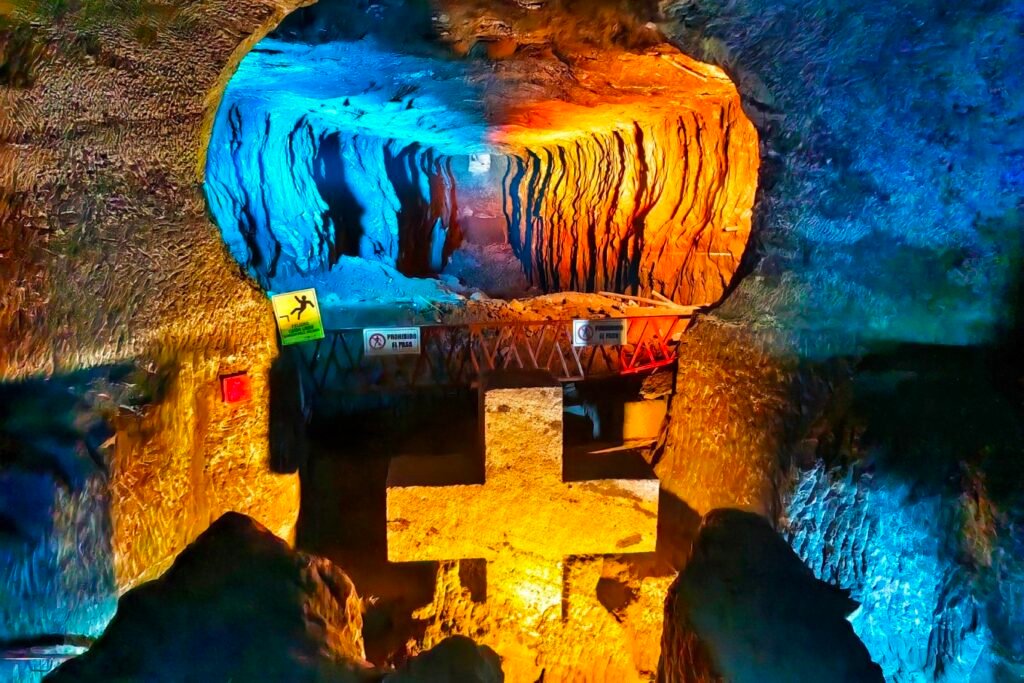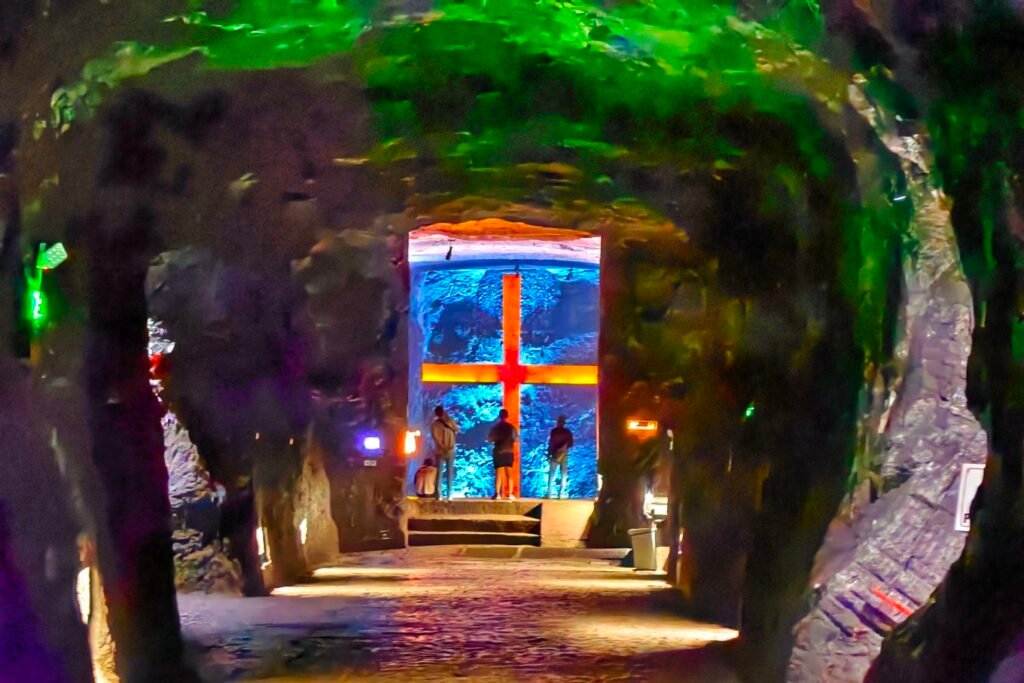Zipaquirá is a peaceful town less than 100 kilometers from Colombia’s capital, Bogotá. Nestled on the Andean plateau, it belongs to the Cundinamarca Province in central Colombia. With its picturesque landscapes and simple, warm-hearted locals, Zipaquirá offers much to explore: from wandering through streets lined with charming old houses to visiting traditional Indigenous villages and experiencing local customs. Visitors can also venture into the Zipaquirá National Park for hiking and enjoy breathtaking mountain views. However, the main attraction here is undoubtedly the Zipaquirá Salt Cathedral—considered Colombia’s greatest wonder. In many ways, Zipaquirá is synonymous with this extraordinary site.


Upon arrival, we headed straight to the salt mine area. Interestingly, while the town sits at the base of a hill, the salt mine is located uphill. Visitors must enter the mine through the mountainside and descend underground. The entrance fee is quite steep—110,000 Colombian pesos (about $30 USD)—but the self-guided audio tour included in the ticket saves the need for a guide.


We first watched an introductory video that gave us an overview of the mine’s impressive history. Beneath the seemingly endless mountain range lies a massive salt deposit stretching over 500 kilometers. The salt reserves are so vast that they could supply the world for a century, making it the second-largest salt mine in the world after the Wieliczka Salt Mine in Poland. The mine’s history dates back to pre-industrial times when Indigenous people manually extracted salt in an unorganized manner. Over time, the mining techniques evolved—moving from traditional manpower to modern directional drilling and high-pressure water injection methods. These innovations have not only lowered production costs but also increased efficiency, with the salt mine estimated to remain active for another 500 years. Despite ongoing operations, tourism is unaffected, and two underground levels remain open to visitors, with more than ten tunnels to explore. At 180 meters below ground lies the grandest highlight—the Salt Cathedral, the largest underground church in the world.


The origins of the cathedral date back to the colonial period. The Spanish colonialists, notorious for their violent exploitation of resources, subjected Indigenous miners to brutal conditions. Death and injury were common, and with little hope of escape, the miners sought solace in faith. They built small altars within the mine, praying for God’s protection. Over time, the number of these altars grew, creating a spiritual atmosphere that eventually led to the construction of a full-fledged church within the salt mine.


The original church was fairly simple, and in the 1990s, local authorities reconstructed it to ensure safety. Rather than resembling a traditional grand cathedral, the Salt Cathedral is an artistic transformation of the mine’s tunnels and caverns. Utilizing the natural structure of the salt deposits, the designers incorporated artistic lighting and sculptures to create a mysterious, spiritual atmosphere. The original tunnels and shafts, adorned with salt-carved crosses and atmospheric lighting, represent the Stations of the Cross, symbolizing the suffering and sacrifice of Jesus Christ. The pathway connects four massive halls, all transformed from mine shafts.


The main hall, with its 74-meter ceiling and over 8,000 square meters of space, can accommodate up to 8,400 people. At the center of the hall is a 16-meter-high illuminated cross that changes colors, standing out dramatically against the salt walls. The massive pillars, altars, and shrines, all carved from salt rock, create a truly awe-inspiring architectural wonder. It’s no surprise that locals refer to it as the “Jewel of Modern Architecture.” This salt cathedral is a fusion of faith and survival, a testament to history and suffering, a blend of architecture and art, and a symbol of Colombian ingenuity—an invaluable cultural heritage.


After immersing ourselves in the cathedral’s spiritual atmosphere, we strolled through the streets of Zipaquirá to reconnect with the simple rhythms of daily life. The town, built along the slopes of the Andes, is filled with rows of red-brick houses topped with tiled roofs, creating a striking visual as the buildings cascade down from the highlands into the valley. It’s rare to see a town of this scale nestled among towering mountains.


At the heart of the town lies the beautiful Villa de Leyva Park. In the center of the plaza stands a monument to Antonio Nariño, a key figure in Colombia’s independence and the inspiration for the country’s national anthem. Unlike other flat, open plazas, this one has an uneven surface, reflecting the mountainous terrain. Surrounding the plaza are several colonial-style buildings, including the Zipaquirá Archaeological Museum, the University of Cundinamarca, and even a military compound. The most eye-catching structure is the grand cathedral with its towering bell tower. The nearby cobblestone streets exude a sense of history, bearing the marks of time. Though the streets form a complex web, exploring the entire town takes just half a day, which is why many visitors opt for a day trip from Bogotá. Even without the Salt Cathedral, Zipaquirá is a town with a rich cultural heritage and unique charm, making it well worth a visit.
After leaving Zipaquirá, we drove for about an hour to reach Lake Guatavita, another must-see destination in Colombia. Located north of Bogotá, this crater lake was formed by a volcanic eruption. Surrounded by dense forests and steep cliffs, the lake is off-limits to unaccompanied visitors—only guided tours are allowed. Visitors join groups of around ten people, with new groups departing every 30 minutes. The guides, often young locals, lead the way while sharing fascinating insights about the tropical plants along the trail.


A short hike brings visitors to a round, traditional wooden hut built by Indigenous people. The hut, now serving as a small exhibition space, is filled with artifacts and images from Indigenous culture. Here, the guide recounts the legendary tale of El Dorado, the “Golden Man.”
According to legend, a wealthy and prosperous kingdom once thrived in this area. Every year, the people held a grand ceremony on the lake. The king, adorned in gold dust and precious jewelry, would sail to the center of the lake on a raft loaded with offerings of gold and jewels. As the drums and music reached a crescendo, the king—shimmering in gold—would leap into the lake to wash off the gold dust, while the priests and people cast their treasures into the water as an offering to the sun god. From afar, the king’s golden figure glittered in the sunlight, earning him the name “Golden Man.” The legend of El Dorado spread far and wide, capturing the imaginations of many.
When the Spanish conquistadors heard the story, they embarked on a frantic quest for the fabled treasure. From the 16th century onward, heavily armed expeditions searched the South American jungles in pursuit of El Dorado, but despite centuries of effort, they never found the legendary “Golden Lake.”
In the early 19th century, German explorers identified Lake Guatavita as the legendary lake. They even attempted to drain the lake in hopes of uncovering the treasure, managing to recover around 300 gold artifacts. Ironically, it wasn’t until 1969—long after the allure of El Dorado had faded—that locals accidentally discovered a pure gold raft near Bogotá, depicting a king and his attendants on a ceremonial journey. This exquisite piece perfectly matches the legendary scene described in the El Dorado myth.


In reality, Colombia was indeed a land of gold. Over 2,000 years ago, the region was already known for its gold production. From the 16th to the 19th century, Colombia produced an average of 3,500 kilograms of gold annually, making it the top producer in the Western Hemisphere. Of course, legends tend to embellish the truth, and the reality seldom matches the grandeur of the myth. Yet, it is precisely these captivating myths that lend a sense of mystery and allure to our journeys. I hope there are even more stories and legends waiting for us on this trip.




